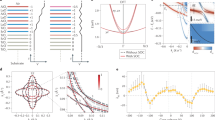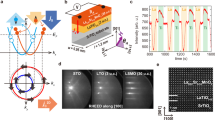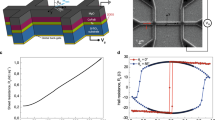Abstract
While spintronics has traditionally relied on ferromagnetic metals as spin generators and detectors, spin–orbitronics exploits the efficient spin–charge interconversion enabled by spin–orbit coupling in non-magnetic systems. Although the Rashba picture of split parabolic bands is often used to interpret such experiments, it fails to explain the largest conversion effects and their relationship with the electronic structure. Here, we demonstrate a very large spin-to-charge conversion effect in an interface-engineered, high-carrier-density SrTiO3 two-dimensional electron gas and map its gate dependence on the band structure. We show that the conversion process is amplified by enhanced Rashba-like splitting due to orbital mixing and in the vicinity of avoided band crossings with topologically non-trivial order. Our results indicate that oxide two-dimensional electron gases are strong candidates for spin-based information readout in new memory and transistor designs. Our results also emphasize the promise of topology as a new ingredient to expand the scope of complex oxides for spintronics.
This is a preview of subscription content, access via your institution
Access options
Access Nature and 54 other Nature Portfolio journals
Get Nature+, our best-value online-access subscription
$29.99 / 30 days
cancel any time
Subscribe to this journal
Receive 12 print issues and online access
$259.00 per year
only $21.58 per issue
Buy this article
- Purchase on Springer Link
- Instant access to full article PDF
Prices may be subject to local taxes which are calculated during checkout





Similar content being viewed by others
Data availability
The data that support the findings of this study are available from the corresponding author on reasonable request.
References
Bychkov, Y. A. & Rashba, E. I. Properties of a 2D electron gas with lifted spectral degeneracy. JETP Lett. 39, 78–81 (1984).
Manchon, A., Koo, H. C., Nitta, J., Frolov, S. M. & Duine, R. A. New perspectives for Rashba spin–orbit coupling. Nat. Mater. 14, 871–882 (2015).
Edelstein, V. M. M. Spin polarization of conduction electrons induced by electric current in two-dimensional asymmetric electron systems. Solid State Commun. 73, 233–235 (1990).
Rojas-Sánchez, J. C. et al. Spin-to-charge conversion using Rashba coupling at the interface between non-magnetic materials. Nat. Commun. 4, 2944 (2013).
Rojas-Sánchez, J.-C. et al. Spin to charge conversion at room temperature by spin pumping into a new type of topological insulator: α-Sn films. Phys. Rev. Lett. 116, 096602 (2016).
Han, W., Otani, Y. & Maekawa, S. Quantum materials for spin and charge conversion. npj Quantum Mater. 3, 27 (2018).
Johansson, A., Henk, J. & Mertig, I. Edelstein effect in Weyl semimetals. Phys. Rev. B 97, 085417 (2018).
Zhang, S. & Fert, A. Conversion between spin and charge currents with topological insulators. Phys. Rev. B 94, 184423 (2016).
Shen, K., Vignale, G. & Raimondi, R. Microscopic theory of the inverse Edelstein effect. Phys. Rev. Lett. 112, 096601 (2014).
Lesne, E. et al. Highly efficient and tunable spin-to-charge conversion through Rashba coupling at oxide interfaces. Nat. Mater. 15, 1261–1266 (2016).
Seibold, G., Caprara, S., Grilli, M. & Raimondi, R. Theory of the spin galvanic effect at oxide interfaces. Phys. Rev. Lett. 119, 256801 (2017).
Ohtomo, A. & Hwang, H. Y. A high-mobility electron gas at the LaAlO3/SrTiO3 heterointerface. Nature 427, 423–426 (2004).
Caviglia, A. D. et al. Electric field control of the LaAlO3/SrTiO3 interface ground state. Nature 456, 624–627 (2008).
Thiel, S., Hammerl, G., Schmehl, A., Schneider, C. W. & Mannhart, J. Tunable quasi-two-dimensional electron gases in oxide heterostructures. Science 313, 1942–1945 (2006).
Lesne, E. et al. Suppression of the critical thickness threshold for conductivity at the LaAlO3/SrTiO3 interface. Nat. Commun. 5, 4291 (2014).
Vaz, D. C. et al. Tuning up or down the critical thickness in LaAlO3/SrTiO3 through in situ deposition of metal overlayers. Adv. Mater. 29, 1700486 (2017).
Rödel, T. C. et al. Universal fabrication of 2D electron systems in functional oxides. Adv. Mater. 28, 1976–1980 (2016).
Posadas, A. B. et al. Scavenging of oxygen from SrTiO3 during oxide thin film deposition and the formation of interfacial 2DEG. J. Appl. Phys. 121, 105302 (2017).
Sing, M. et al. Profiling the interface electron gas of LaAlO3/SrTiO3 heterostructures with hard X-Ray photoelectron spectroscopy. Phys. Rev. Lett. 102, 176805 (2009).
Hurand, S. et al. Field-effect control of superconductivity and Rashba spin-orbit coupling in top-gated LaAlO3/SrTiO3 devices. Sci. Rep. 5, 12751 (2015).
Tserkovnyak, Y., Brataas, A. & Bauer, G. E. W. Enhanced Gilbert damping in thin ferromagnetic films. Phys. Rev. Lett. 88, 117601 (2002).
Rojas-Sánchez, J.-C. et al. Spin pumping and inverse spin Hall effect in germanium. Phys. Rev. B 88, 064403 (2013).
Pham, V. T. et al. Ferromagnetic/nonmagnetic nanostructures for the electrical measurement of the spin Hall effect. Nano Lett. 16, 6755–6760 (2016).
Noel, P. et al. Highly efficient spin-to-charge current conversion in strained HgTe surface states protected by a HgCdTe layer. Phys. Rev. Lett. 120, 167201 (2018).
Mendes, J. B. S. et al. Dirac-surface-state-dominated spin to charge current conversion in the topological insulator (Bi0.22Sb0.78)2Te3 films at room temperature. Phys. Rev. B 96, 180415 (2017).
Karube, S., Kondou, K. & Otani, Y. Experimental observation of spin-to-charge current conversion at non-magnetic metal/Bi2O3 interfaces. Appl. Phys. Express 9, 033001 (2016).
King, P. D. C. et al. Quasiparticle dynamics and spin-orbital texture of the SrTiO3 two-dimensional electron gas. Nat. Commun. 5, 3414 (2014).
Zhong, Z., Tóth, A. & Held, K. Theory of spin-orbit coupling at LaAlO3/SrTiO3 interfaces and SrTiO3 surfaces. Phys. Rev. B 87, 161102 (2013).
Khalsa, G. & MacDonald, A. H. Theory of the SrTiO3 surface state two-dimensional electron gas. Phys. Rev. B 86, 125121 (2012).
McKeown Walker, S. et al. Carrier-density control of the SrTiO3 (001) surface 2D electron gas studied by ARPES. Adv. Mater. 27, 3894–3899 (2015).
Vivek, M., Goerbig, M. O. & Gabay, M. Topological states at the (001) surface of SrTiO3. Phys. Rev. B 95, 165117 (2017).
Zhong, Z., Tóth, A. & Held, K. Theory of spin-orbit coupling at LaAlO3/SrTiO3 interfaces and SrTiO3. Phys. Rev. B 87, 161102 (2013).
Kim, J. et al. Evaluation of bulk-interface contributions to Edelstein magnetoresistance at metal/oxide interfaces. Phys. Rev. B 96, 140409 (2017).
Dey, R., Prasad, N., Register, L. F. & Banerjee, S. K. Conversion of spin current into charge current in a topological insulator: Role of the interface. Phys. Rev. B 97, 174406 (2018).
Herranz, G. et al. High mobility in LaAlO3/SrTiO3 heterostructures: origin, dimensionality, and perspectives. Phys. Rev. Lett. 98, 216803 (2007).
Manipatruni, S. et al. Scalable energy-efficient magnetoelectric spin–orbit logic. Nature 565, 35–42 (2019).
Sagasta, E. et al. Tuning the spin Hall effect of Pt from the moderately dirty to the superclean regime. Phys. Rev. B 94, 060412(R) (2016).
Manipatruni, S., Nikonov, D. E. & Young, I. A. Beyond CMOS computing with spin and polarization. Nat. Phys. 14, 338–343 (2018).
Varignon, J., Vila, L., Barthélémy, A. & Bibes, M. A new spin for oxide interfaces. Nat. Phys. 14, 322–325 (2018).
Xiao, D., Zhu, W., Ran, Y., Nagaosa, N. & Okamoto, S. Interface engineering of quantum Hall effects in digital transition metal oxide heterostructures. Nat. Commun. 2, 596 (2011).
Acknowledgements
This work received support from the ERC Consolidator Grant no. 615759 ‘MINT’, the QUANTERA project ‘QUANTOX’, the French ANR programme through projects OISO (ANR-17-CE24-0026-03), TOPRISE (ANR-16-CE24-0017) and the Laboratoire d’Excellence LANEF (ANR-10-LABX-51-01). M.B. thanks the Alexander von Humboldt Foundation for supporting his stays at Martin-Luther-Universität Halle. F.T. acknowledges support by research grant no. VKR023371 (SPINOX) from VILLUM FONDEN. A.J., B.G. and I.M. acknowledge support by Priority Program SPP 1666 and SFB 762 of Deutsche Forschungsgemeinschaft. D.C.V. thanks the French Ministry of Higher Education and Research and CNRS for financing his PhD thesis. We thank H. Jaffrès for insightful comments on tunnel escape times, M. Sing for his help with XPS analysis and E. Schierle for his assistance with X-ray absorption spectroscopy measurements.
Author information
Authors and Affiliations
Contributions
M.B. proposed and supervised the study with help from L.V., J.-P.A., A.B. and A.F. D.C.V. prepared the samples with the help of F.T. and L.M.V.-A. and performed XPS experiments and analysed the data with A.S. D.C.V., G.S. and N.B. measured the magnetotransport properties and analysed the results. H.O. prepared the samples for STEM and EELS and performed the observations and spectroscopy measurements. S.V. performed the X-ray absorption measurements and analysed the data. S.M.-W., F.Y.B. and F.B. performed the ARPES measurements and their analysis. P.N. performed the spin-pumping experiments and analysed the data with D.C.V., L.V., J.-P.A. and M.B. P.B., M.V. and M.G. conducted the Poisson–Schrödinger calculations. A.J. and B.G. performed the tight-binding and Boltzmann calculations under the supervision of I.M., with input from M.V., M.G. and M.B. D.C.V. and M.B. wrote the manuscript with input from all authors. All authors discussed the results and contributed to their interpretation.
Corresponding authors
Ethics declarations
Competing interests
The authors declare no competing interests.
Additional information
Publisher’s note: Springer Nature remains neutral with regard to jurisdictional claims in published maps and institutional affiliations.
Supplementary information
Supplementary Information
Supplementary Figs. 1–15, Notes 1–12 and refs. 1–13
Rights and permissions
About this article
Cite this article
Vaz, D.C., Noël, P., Johansson, A. et al. Mapping spin–charge conversion to the band structure in a topological oxide two-dimensional electron gas. Nat. Mater. 18, 1187–1193 (2019). https://doi.org/10.1038/s41563-019-0467-4
Received:
Accepted:
Published:
Issue Date:
DOI: https://doi.org/10.1038/s41563-019-0467-4
This article is cited by
-
Observation of the orbital inverse Rashba–Edelstein effect
Nature Physics (2023)
-
Non-volatile electric control of spin-orbit torques in an oxide two-dimensional electron gas
Nature Communications (2023)
-
Gate-tuneable and chirality-dependent charge-to-spin conversion in tellurium nanowires
Nature Materials (2022)
-
Competing electronic states emerging on polar surfaces
Nature Communications (2022)
-
Superfluid stiffness of a KTaO3-based two-dimensional electron gas
Nature Communications (2022)



